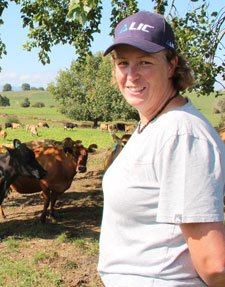 “That’s what could happen over the long term, once we’ve
built up enough data from SPACE™ over five or 10 years.”
“That’s what could happen over the long term, once we’ve
built up enough data from SPACE™ over five or 10 years.”
SPACE™ utilises detailed satellite images of a farm’s pasture cover, emailing results direct to farmers within 24 hours, allowing for immediate estimates of feed availability by individual paddock.
For now, the system automatically generates a feed wedge for instant use, with its main application being to help farmers with feed budgeting over the short- to medium-term, especially during winter and spring.
Louise, who peak-milks 360 cows on her 100 ha-effective farm (owned in conjunction with husband Tony), says using SPACE™ to replace farm walks and plate monitoring is a “no-brainer.”
“Pasture management is the foundation stone of the entire business, really. Grass is the major feed source so it’s just essential to manage it properly – to get the most out of pasture any farmer knows they’ve got to identify surpluses and deficits correctly, because it has a direct influence on quality.
“Without quality pasture it doesn’t matter how good your cows are, they’re just not going to milk well.”
Louise knows a thing or two about quality dairying – her predominantly Jersey and Jersey-cross herd sits inside the top five percent of the national herd when it comes to breeding worth (BW).
She’s been using SPACE™ for about a year now, and expects the system will continue to evolve and become an increasingly powerful tool as more data from her farm is gathered from season-to-season.
“I think in future we might be able to combine the information through MINDA LIVE and perhaps look at nutrient allocation, for example. Or we might look at trends and soil tests, and understand links between specific products going on certain paddocks. I’m sure we’ll be able to sit and analyse things over time. The more data you collect, the more you can get into performance over time and find out why one paddock does better than others.”
Prior to using SPACE™, Louise was plate-metering her entire farm.
“I’d enter the covers directly in to MINDA as I walked the farm, and from April to December I’d try to do that every second week.
“It would take me nearly three hours to do the walk, and in June and July I found I wasn’t doing it as often as I wanted to, because life gets so busy, and gut-feeling isn’t enough when you’ve got other staff involved.”
She found out about SPACE™ through reading an article about a farmer who was using it in Canterbury, and became excited when she saw it launch in the Waikato.
“It took a while to set-up and iron out a few creases. We had a few hiccups because this is very much a mixed-contour farm. We got our reports quite regularly from about 20 May last year, and although we had issues with cloud cover we were getting enough for a decent gauge on growth rates and total cover.”
Cloud cover impedes the ability of the satellite to pick up clear images of the farm.
“Generally if there’s cloud cover here, there’s also rain, so I wouldn’t be going on a farm walk anyway,” Louise says.
“But it does have its limitations – it doesn’t read covers over 3500 dry matter (DM/ha); we had a paddock of annuals that got really long and we couldn’t graze it because of high nitrate levels – it got up to 5000 (DM/ha) on the plate meter. But that’s an outlier, it’s not typical, and we knew about that.”
Louise is dismissive of criticism that questions the accuracy of SPACE™.
“It’s not perfect, but it’s certainly more accurate than not measuring things at all.
“When a (SPACE™) report comes through we take it down to the cowshed where we keep a record of grazing dates on a big whiteboard. As cows leave the paddock we write the dates up, and we know what’s coming up with the report so we’ll write down the top 10 paddocks on the board, which is pretty much the grazing plan for the week.
“If something looks wrong we’ll go and look at the paddock to be sure. Because we’re a mixed contour farm, if it rains during the week and we don’t want to go in to a particular paddock we make adjustments. SPACE™ is just another useful selection tool, but it’s stopped me walking 8.5km every two weeks and saved me up to three hours a time.”
Cost is also not a factor for Louise (for a 100ha farm, the annual cost is $2000/annum).
“We don’t bat an eyelid if we need to spend $6000 to feed palm kernel when the cows need it, so why would I debate spending a few grand on pasture cover reports that turn up in my inbox, which saves me three hours of doing farm walks each fortnight?

Each SPACE™ report provides:
- An image of the farm, presenting pasture cover variation by colour, illustrating differences across the farm and within each paddock:
- An image of your farm showing any areas covered by shadow and cloud;
- A detailed feed wedge; and
- The latest paddock rankings, together with estimated dry matter per hectare (kgDM/ha) for each paddock.




